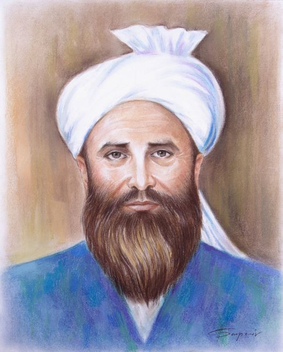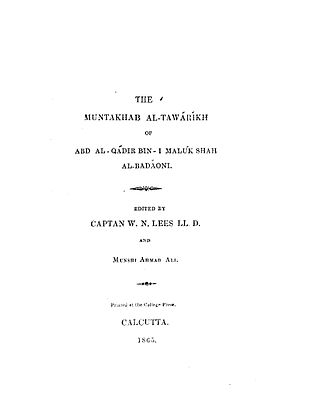Related Research Articles

The Durrani Empire, colloquially known as the Afghan Empire, or the Sadozai Kingdom, was an Afghan empire founded by the Durrani tribe of Pashtuns under Ahmad Shah Durrani in 1747, which spanned parts of Central Asia, the Iranian plateau, and the Indian subcontinent. At its peak, it ruled over present-day Afghanistan, much of Pakistan, parts of northeastern and southeastern Iran, eastern Turkmenistan, and northwestern India. Next to the Ottoman Empire, the Durrani Empire is considered to be among the most significant Islamic empire of the second half of the 18th century.

Mirza Shahab-ud-Din Muhammad Khurram, commonly called Shah Jahan I, also called Shah Jahan the Magnificent, was Emperor of Hindustan from 1628 until his deposition in 1658. As the fifth Mughal emperor, his reign marked the zenith of Mughal architectural and cultural achievements.

Multan is a city in Punjab, Pakistan, located on the bank of river Chenab. It is one of the five largest urban centres of Pakistan in 2024 and is the administrative centre of Multan Division. It is a major cultural, religious and economic centre of Punjab region, Multan is one of the oldest cities of Asia with a history stretching deep into antiquity.

The Lahore Fort is a citadel in the walled interior of Lahore in Punjab, Pakistan. The fortress is located at the northern end of the Walled City and spreads over an area greater than 20 hectares. It contains 21 notable monuments, some of which date to the era of Emperor Akbar. The Lahore Fort is notable for having been almost entirely rebuilt in the 17th century, when the Mughal Empire was at the height of its splendor and opulence.

Mandu or Mandavgad is an ancient city in the present-day Mandav area of the Dhar district. It is located in the Malwa and Nimar region of western Madhya Pradesh, India, at 35 km from Dhar city. In the 11th century, Mandu was the sub division of the Tarangagadh or Taranga kingdom. This fortress town on a rocky outcrop about 100 km (62 mi) from Indore is celebrated for its architecture.

Mughal architecture is the type of Indo-Islamic architecture developed by the Mughals in the 16th, 17th and 18th centuries throughout the ever-changing extent of their empire in the Indian subcontinent. It developed from the architectural styles of earlier Muslim dynasties in India and from Iranian and Central Asian architectural traditions, particularly Timurid architecture. It also further incorporated and syncretized influences from wider Indian architecture, especially during the reign of Akbar. Mughal buildings have a uniform pattern of structure and character, including large bulbous domes, slender minarets at the corners, massive halls, large vaulted gateways, and delicate ornamentation; examples of the style can be found in modern-day Afghanistan, Bangladesh, India and Pakistan.
The History of India, as Told by Its Own Historians is a book comprising translations of medieval Persian chronicles based on the work of Henry Miers Elliot. It was originally published as a set of eight volumes between 1867–1877 in London. The translations were in part overseen by Elliot, whose efforts were then extended and edited posthumously by John Dowson.
The Gakhar is a historical Punjabi Muslim tribe with origins in the northern Punjab, Pakistan.

ʽAbd al-Qadir or Abdul Qadir Badayuni (1540–1615) was an Indian writer, historian, and translator. He lived in the Mughal Empire. He translated into Persian the Hindu works, the Ramayana and the Mahabharata (Razmnama).

Bāyazīd Khān Ansārī, commonly known as Pīr Rōshān or Pīr Rōkhān, was an Ormur warrior, Sufi poet and revolutionary leader. He wrote mostly in Pashto, but also in Persian, Urdu and Arabic. His mother tongue was Ormuri. He is known for founding the Roshani movement, which gained many followers in present-day Pakistan and Afghanistan, and produced numerous Pashto poets and writers.

Delhi has been an important political centre of India as the capital of several empires. The recorded history of Delhi begins with the 8th century Tomar Rajput dynasty. It is considered to be a city built, destroyed and rebuilt several times, as outsiders who successfully invaded the Indian subcontinent would ransack the existing capital city in Delhi, and those who came to conquer and stay would be so impressed by the city's strategic location as to make it their capital and rebuild it in their own way.

Khizr Khan was the founder of the Sayyid dynasty, the fourth ruling dynasty of the Delhi sultanate, in northern India soon after the invasion of Timur and the fall of the Tughlaq dynasty. Khizr Khan was Governor of Multan under the Tughlaq ruler, Firuz Shah Tughlaq, and was known to be an able administrator. He did not take up any royal title due to fear of invasion by Amir Timur and contended himself with the titles of Rayat-i-Ala and Masnad-i-Aali or. During his reign, coins were continued to be struck in the name of previous Tughlaq rulers. After his death on 20 May 1421, he was succeeded by his son Mubarak Khan, who took the title of Muizz-ud-Din Mubarak Shah.

Mirza Sulaiman Shikoh was a Mughal prince and the eldest son of Crown prince Dara Shikoh. He was executed in May 1662 at Gwalior Fort on the orders of his paternal uncle, Emperor Aurangzeb.
The Battle of Jajau was fought between the two Mughal princes and brothers Bahadur Shah I and Muhammad Azam Shah on 20 June 1707. In 1707, their father Aurangzeb died without having declared a successor; instead leaving a will in which he instructed his sons to divide the empire between themselves. Their failure to reach a satisfactory agreement led to a military conflict. After Azam Shah and his three sons were killed in the Battle of Jajau, Bahadur Shah I was crowned as the Mughal emperor on 19 June 1707 at the age of 63.

The decline of the Mughal Empire was a period in Indian history roughly between the early 18th century and mid 19th Century where the Mughal Empire, which once dominated the subcontinent, experienced a large scale decline. There are various factors responsible for this decline such as internal conflicts, Rajput, Sikh and Maratha rebellions, Afghan and Persian invasions and expansion of East India Company influence and power.
Punjabi Muslims are Punjabis who are adherents of Islam. With a population of more than 112 million, they are the third-largest predominantly Islam-adhering Muslim ethnicity in the world, after Arabs and Bengalis.

Muntakhab-ut-Tawarikh orTarikh-i-Bada'uni, Selection of Chronicles by `Abd al-Qadir Bada'uni (1540–1605) is a book describing the early Mughal history of India, covering the period from the days of Ghaznavid reign until the fortieth regnal year of Mughal Emperor Akbar.
Muhammad Hashim, better known by his title Khafi Khan, was an Indo-Persian historian of Mughal India. His career began about 1693–1694 as a clerk in Bombay. He served predominantly in Gujarat and the Deccan regions, including the final decade of Mughal emperor Aurangzeb. He authored the controversial and in part "patently fictitious" Muntakhab-al Lubab – a Persian language book about the history of India during the Mughal period, completed in 1731. It has been a much studied, contested source of information about the Mughal history, particularly Shah Jahan and Aurangzeb.

The Mughal–Afghan wars were a series of wars that took place during the 16th and 18th centuries between the Mughal Empire of India and different Afghan tribes and kingdoms.
References
- 1 2 3 4 5 Harbans Singh, ed. (1992). The Encyclopaedia of Sikhism: M-R. Punjabi University. p. 148. ISBN 978-81-7380-349-9.
- ↑ B. Sheikh Ali (1978). History, Its Theory and Method. Macmillan. p. 396.
- ↑ H. Beveridge (1993). "K̲h̲wāfī K̲h̲ān". In M. Th. Houtsma (ed.). E. J. Brill's First Encyclopaedia of Islam, 1913–1936. BRILL. pp. 868–869. ISBN 90-04-09790-2.